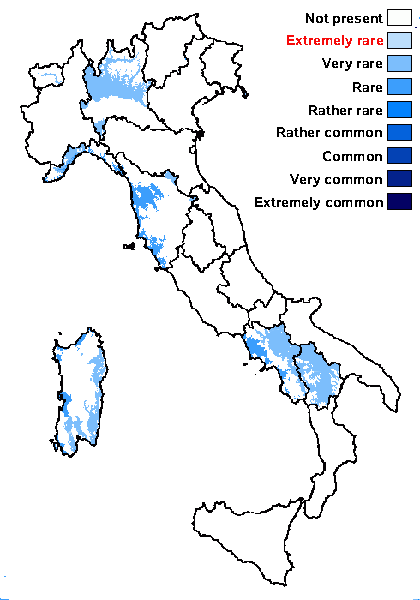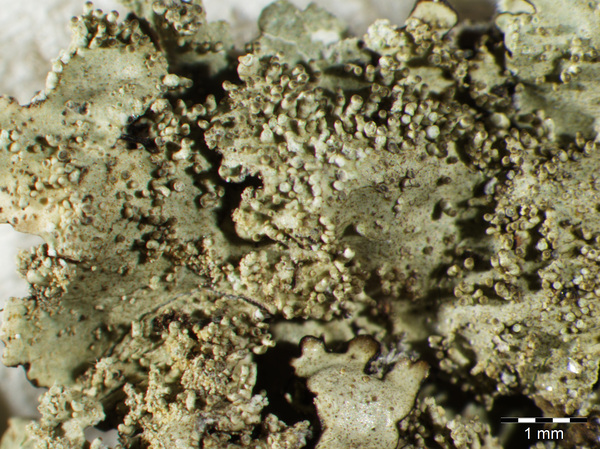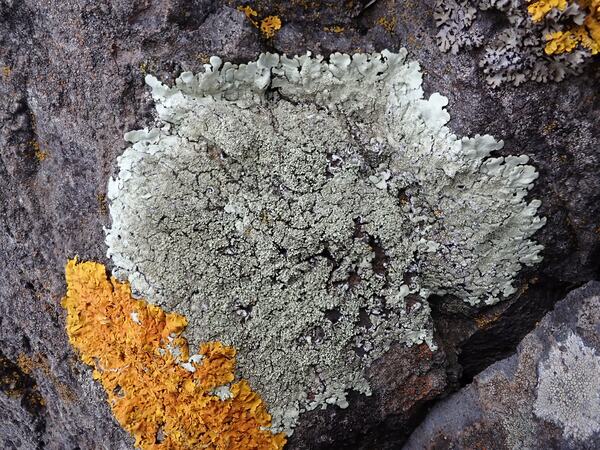Xanthoparmelia verrucigera (Nyl.) Hale
Smithsonian Contr. Bot., 74: 220, 1990. Basionym: Parmelia verrucigera Nyl. - Flora, 55: 426, 1872.
Synonyms: Parmelia conspersa var. isidiophora Trevis.; Parmelia conspersa var. lusitana (Nyl.) Lettau; Parmelia conspersa var. verrucigera (Nyl.) Boistel; Parmelia isidiigera f. ligustica Gyeln.; Parmelia lusitana Nyl.; Parmelia pseudoservitiana Gyeln.; Parmelia pulvinaris var. mediterranea Gyeln.; Parmelia servitiana Gyeln.; Parmelia tarpatakensis Gyeln.; Xanthoparmelia lusitana (Nyl.) Krog
Distribution: N - VG (Giordani & al. 2002b), Frl (Giordani & al. 2002b), Ven (Giordani & al. 2002b), Lomb (Favero-Longo & al. 2023), VA (Matteucci & al. 2015c), Lig (Giordani & al. 2002b, 2009, 2025, Rizzi & Giordani 2013). C - Tosc (Giordani & al. 2002b), Sar (Giordani & al. 2002b, Rizzi & al. 2011). S - Camp (Giordani & al. 2002b), Bas (Giordani & al. 2002b).
Description: Thallus foliose, heteromerous, dorsiventral, adnate to loosely adnate, forming up to 10 cm wide rosettes. Lobes elongate, flat to slightly convex, separate to weakly imbricate,1-3 mm wide, yellow-green, smooth, shiny, epruinose and emaculate, densely covered in cylindrical, mostly coralloid, branched isidia. Lower surface black, with simple to furcate, black rhizines. Upper cortex paraplectenchymatous, of anticlinally arranged hyphae or of isodiametrical cells, with a pored epicortex, the cell walls with Xanthoparmelia-type lichenan; medulla white; lower cortex paraplectenchymatous. Apothecia rare, lecanorine, substipitate, 3-7 mm across, with a brown, epruinose disc, and an isidiate thalline margin. Epithecium brown; hymenium and hypothecium colourless; paraphyses simple; hypothecium colourless. Asci 8-spored, clavate, the K/I+ blue tholus penetrated by a faintly amyloid apical cushion with parallel or diverging flanks, the wall K/I-, surrounded by a K/I+ blue outer layer, Lecanora-type. Ascospores 1-celled, hyaline, ellipsoid, 6-10 x 4-6 µm. Pycnidia immersed, black. Photobiont chlorococcoid. Spot tests: upper cortex K-, C-, KC+ yellowish, P-; medulla K+ persistently yellow, C-, KC-, P+ orange, UV-. Chemistry: upper cortex with usnic acid (major); medulla with stictic, lusitanic and verrucigeric acids. Note: on siliceous rocks; related to X. conspersa, but chemically different (stictic and lusitanic acids, lacking norstictic acid).
Growth form: Foliose, broad lobed
Substrata: rocks
Photobiont: green algae other than Trentepohlia
Reproductive strategy: mainly asexual, by isidia, or isidia-like structures (e.g. schizidia)
Commonnes-rarity: (info)
Alpine belt: absent
Subalpine belt: absent
Oromediterranean belt: absent
Montane belt: absent
Submediterranean belt: very rare
Padanian area: absent
Humid submediterranean belt: absent
Humid mediterranean belt: rare
Dry mediterranean belt: absent

Predictive model
Herbarium samples

Harrie Sipman – Source http://www.bgbm.fu-berlin.de/sipman/Zschackia/AegeanLichens/CaloplacaAC.htm - As Caloplaca oasis


P.L. Nimis; Owner: Department of Life Sciences, University of Trieste
Herbarium: TSB (7653)
2002/02/13
Growth form: Foliose, broad lobed
Substrata: rocks
Photobiont: green algae other than Trentepohlia
Reproductive strategy: mainly asexual, by isidia, or isidia-like structures (e.g. schizidia)
Commonnes-rarity: (info)
Alpine belt: absent
Subalpine belt: absent
Oromediterranean belt: absent
Montane belt: absent
Submediterranean belt: very rare
Padanian area: absent
Humid submediterranean belt: absent
Humid mediterranean belt: rare
Dry mediterranean belt: absent

Predictive model
| Herbarium samples |

Harrie Sipman – Source http://www.bgbm.fu-berlin.de/sipman/Zschackia/AegeanLichens/CaloplacaAC.htm - As Caloplaca oasis


 INDEX FUNGORUM
INDEX FUNGORUM
 GBIF
GBIF
 DOLICHENS
DOLICHENS




